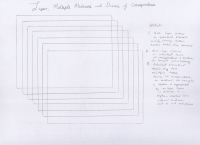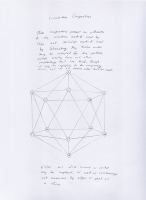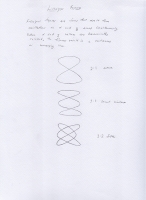Visual Music Workshop, 2017
This is a condensed version of the illustrations contained in the Visual Music notebook, a collection of 162 illustrations outlining visual means of creating music and the visualization of music. Seven elements from music and the visual are given correspondences to form a comprehensive theory for this highly sought after area of interest in the arts. Some of the highlights from the notebook include color harmony using Indian ragas - as raga means "to color the mind", mapping the 12 notes of Western music to an icosahedron, the use of spheres and geodesics, the use of light and dark, various layouts resulting from musical elements and effects to them including projections, reflections, refraction, and diffraction, movement and basic choreographic notation for objects or dance, layers of correspondence, and techniques resulting from drawing instruments and those resulting from musical performance.
1. Layers with a different musical element on each layer, a different device of correspondence, and individual elements of music having multiple layers.
2. Light and dark corresponding to intervals with their inversions, a hierarchy of seventh chords based on major and minor thirds, a hierarchy of triads based on major and minor thirds, the order of intervals by relative dissonance in just intonation by number of oscillations before meeting together, problems with weighing and placing the tritone.
3. A color wheel as it corresponds to intervals for practical use, the color wheel can be rotated or flipped.
4. Color harmony and triads, shared notes between first and second chords being the same color, rotating the color wheel for a note in the chord to be at the top, having the color wheel fixed from the tonic or a note in the scale, having the color wheel fixed from a note in the first chord, each note being based on another note in the same chord, another note in the first chord, or a note in the scale.
5. Seventh chords and color harmony, considering the seventh of the chord from the root of the chord or from the fifth rotating the wheel for the fifth to be at the top, color and melody, notes corresponding to a fixed wheel, colors based on intervals, colors based on interval from tonic, second melodic lines, a color keyboard with the circle of fifths corresponding to a color wheel.
6. Color and ragas, gradients from 1-5 and 5-1 with either the root or fifth the same for the inside and outside ragas, alternate arrangements of the gradients, rotating the colors for relative modes, changing the tetrachord gradients for a parallel mode.
7. Randomized colors for chance pieces, interval color wheel assigned to a keyboard, possible adjustments for the V chord, other uses of color.
8. Points, Nodes, or Bubbles and musical elements, lines as they correspond to texture, 1 as 2, 3, or 4 in texture, 2, 3, or 4 as 1 in texture.
9. Circles, circular staves, correspondences of elements to radius, circumference, inside of circle or point on the circumference, concentric rings, overlapping rings, adjacent rings.
10. Tree rings, simple objects and the trunk or lowest ring, complex objects as rings or relationships, relationships to and from objects, encompassing, shared, necessitating, and separate relationships with similarities, building upwards with rings containing relationships of objects in lower rings.
11. Icosahedron compositions, as an alternate to Cage and Schoenberg.
12. Dodecahedron compositions, with pentatonic scales corresponding to each face.
13. Geodesic compositions with texture alternating from monophonic to polyphonic.
14. Lissajous figures, simultaneous oscillations on x and y axes, forms resulting from harmonic ratios.
15. Layouts using polar and Cartesian graphs and corresponding musical elements.
16. Transposition and rotation.
17. Reflection, inversion, retrograde.
18. Projection, changing size, changing shape.
19. Refraction, bending of objects.
20. Diffraction and interference, possible musical correspondence.
21. Chladni plates, standing wave nodal lines resulting from resonance of a plate where no vibration occurs and powder distributed over the surface accumulates.
22. Movement, direction, angle, duration, distance, curvature, rotation, and alteration.
23. Basic types of movement associated with rhythmic figures.
24. Techniques in visual art as they may correspond to technique in music or another element of music.























